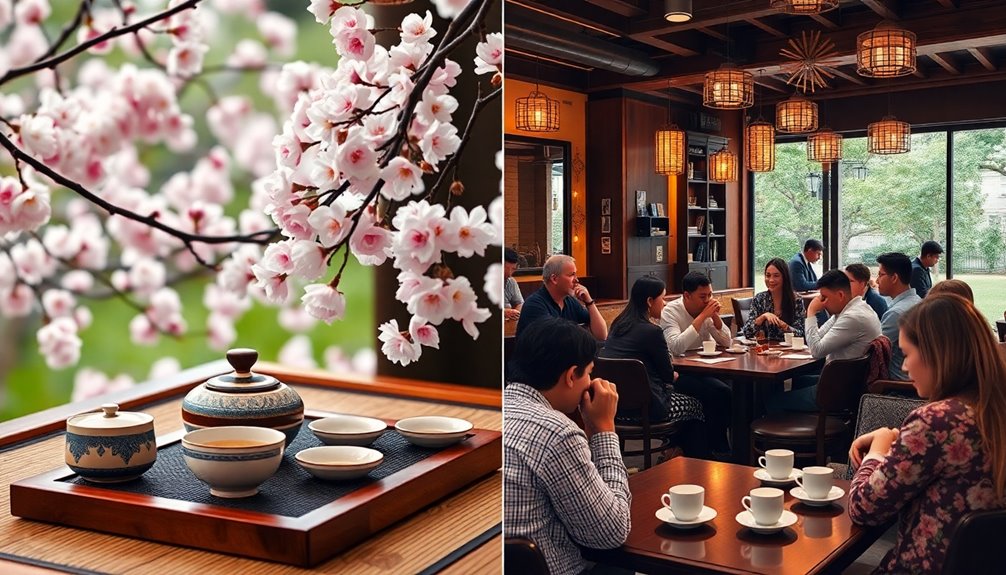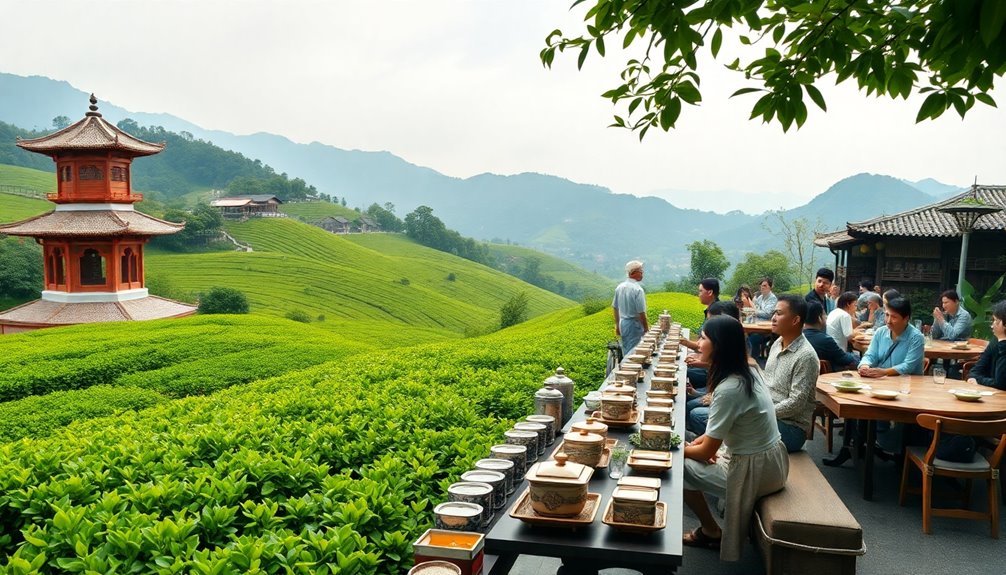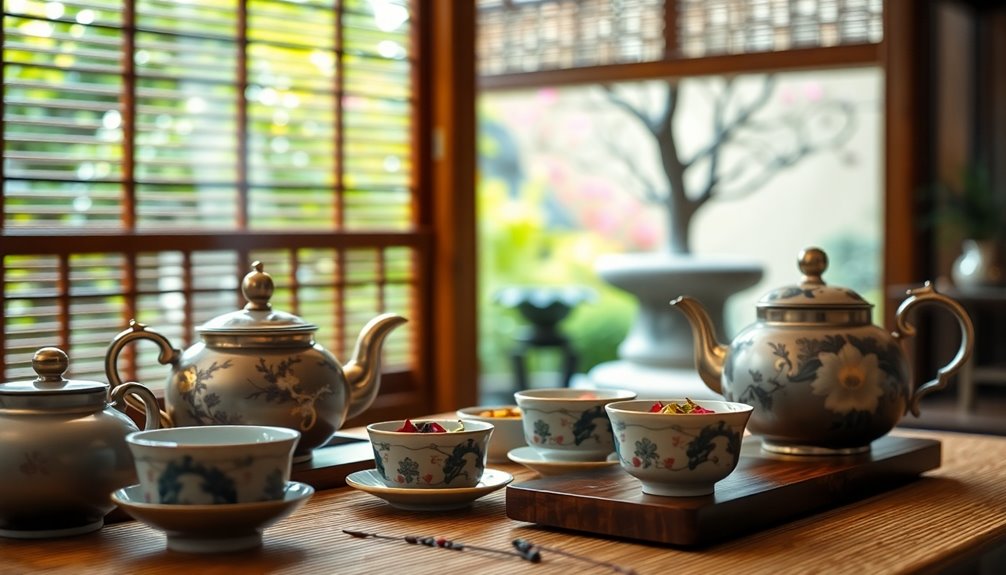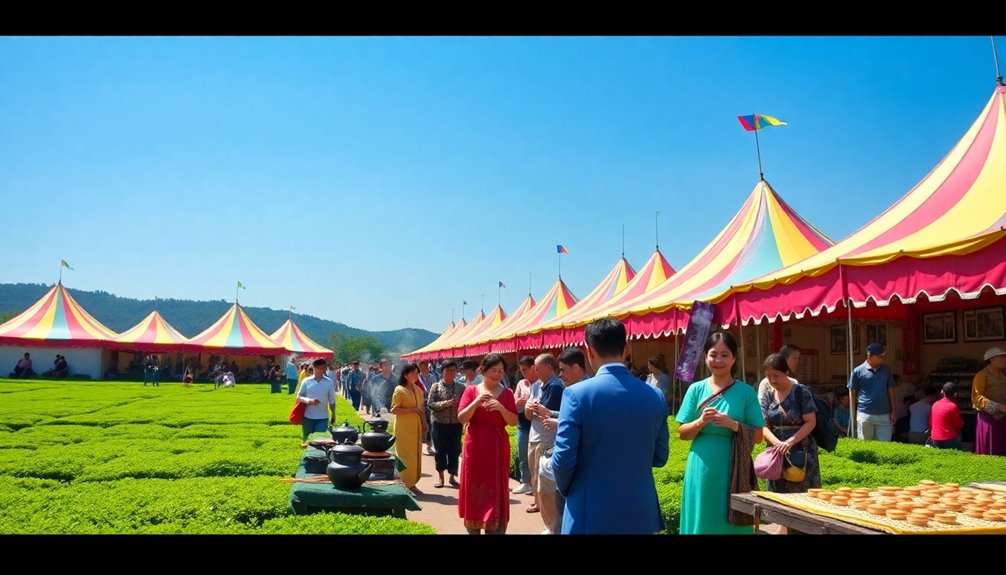Tea has come a long way, starting in ancient China around 2737 B.C.E. as a medicinal drink. As you explore its journey, you'll see how it became a beloved social beverage during the Tang Dynasty, thanks to the famous poet Lu Yu. By the 17th century, tea had crossed oceans, establishing itself in British society as a status symbol. From the elegant afternoon teas to the festive Japanese tea ceremonies, tea continues to play important roles in cultural exchanges and diplomacy. There's so much more to discover about its modern twists, which keep this vibrant tradition alive today.
Key Takeaways
- Tea originated in ancient China as a medicinal drink before evolving into a social beverage during the Tang Dynasty.
- The Japanese tea ceremony and Chinese tea culture developed unique rituals emphasizing harmony, nature, and community bonding.
- Tea became a status symbol in Europe during the 17th century, especially after Queen Catherine of Braganza popularized it in Britain.
- The Boston Tea Party marked a shift in tea's status, transforming it into a symbol of defiance against British rule in America.
- Today, the modern tea industry focuses on sustainability, ethical sourcing, and promoting diverse tea traditions for social and health benefits.
Introduction

Tea culture has a rich history that spans millennia, rooted in ancient traditions and evolving through various societies.
It all began in ancient China, where Emperor Shen Nong discovered tea around 2737 B.C.E. by accident when leaves fell into boiling water. At first, tea was seen as a medicinal drink, but during the Tang dynasty (618-907 C.E.), it blossomed into a popular social beverage. This shift led to the writing of "Cha Ching" by Lu Yu, which shared details about different tea types and preparation methods.
When Buddhist monks introduced tea to Japan in the 9th century, they created unique practices, including the ceremonial tea preparation called Chanoyu, which focuses on art and spirituality.
By the 17th century, European traders encountered tea, and it quickly became a status symbol, especially among the upper classes in Britain. Afternoon tea, popularized by Anna, the Duchess of Bedford, in the 1840s, allowed people to enjoy tea together.
Today, modern tea culture features a wide variety of flavors and health benefits, making tea the world's second most consumed beverage after water.
It's incredible how tea continues to connect people across different cultures!
Tea's Role in Diplomacy

In today's world, tea continues to be significant in diplomacy.
Countries host tea events and cultural exchanges to promote international relations and mutual understanding, proving that tea remains an important part of building relationships across the globe.
Cultural Rituals Surrounding Tea

Building on tea's diplomatic significance, cultural rituals surrounding this beloved beverage highlight its role in fostering connections within communities and across borders.
In Japan, the tea ceremony, or Chanoyu, is a beautiful ritual that promotes harmony, respect, and tranquility. It turns tea preparation into a spiritual experience influenced by Zen Buddhism.
Meanwhile, Chinese tea culture features intricate ceremonies that celebrate nature and bring people together. The variety of teas and serving techniques create a memorable experience for everyone involved.
In Britain, afternoon tea became a popular social custom in the 18th century. You can enjoy finger sandwiches, scones, and pastries alongside a warm cup of tea, making it a delightful social event.
Don't forget about Moroccan mint tea! This unique preparation involves pouring tea from a height, creating frothy tops that symbolize hospitality and social connection.
Additionally, Taiwanese bubble tea represents a modern twist on tea culture. Combining traditional tea with milk, sweeteners, and chewy tapioca pearls, it offers a fun social beverage experience.
These cultural rituals not only celebrate tea but also strengthen bonds and create lasting memories with family and friends.
Tea as a Status Symbol

How has tea evolved into a powerful status symbol throughout history?
In ancient China, during the Tang dynasty, tea ceremonies became a way for the elite to showcase their social hierarchy and cultural refinement. This tradition laid the groundwork for tea as a status symbol.
By the 17th century, tea made its way to Europe and quickly became a luxury item, consumed mainly by the upper classes.
Queen Catherine of Braganza's love for tea in the 1660s helped cement its association with nobility and high society.
Then, in the 1840s, Anna, the Duchess of Bedford, popularized afternoon tea, creating a social event that signified wealth and leisure among the British upper class.
In America, tea's role shifted dramatically during the Boston Tea Party, where it became a symbol of defiance against British rule. This added layers to its status within the evolving national identity.
Today, tea still carries an air of sophistication, reminding us of its rich history. Whether enjoyed in a grand ceremony or a casual setting, tea continues to reflect cultural refinement and social standing.
Colonial Exploitation of Tea Production

Now, the tea industry is working to learn from its past.
Movements toward ethical sourcing and sustainability are gaining momentum, aiming to empower local farmers and improve working conditions.
Practical Applications

As the tea industry embraces ethical sourcing and sustainability, it's important to consider how this evolution can enhance your tea experience. You can explore the rich culture of tea by trying different styles and traditions.
For instance, why not host your own afternoon tea? Inspired by Anna, the Duchess of Bedford, you can create a delightful social gathering. Serve finger sandwiches, scones, and a variety of teas to enjoy with friends!
You might also want to experience the beauty of the Japanese tea ceremony. This ancient practice emphasizes mindfulness and appreciation for tea, making it a wonderful way to slow down and connect with your surroundings.
Don't forget about iced tea! Introduced at the 1904 World's Fair, it has grown in popularity in the U.S. and can be a refreshing option for warm days.
In modern tea culture, many people are drawn to diverse teas for their health benefits. Herbal, green, and specialty teas can support your well-being while providing tasty options for social gatherings. Additionally, exploring the caffeine content in espresso can enhance your understanding of how various beverages affect your energy levels.
Frequently Asked Questions
How Did Tea Change Over Time?
Tea's changed dramatically over time. You've seen it transition from a medicinal brew in ancient China to a global social staple. Today, you enjoy diverse varieties, innovative drinks, and the health benefits it offers.
What Is the Historical Background of the Tea Industry?
You'll find the tea industry began in ancient China, with Emperor Shen Nong discovering it. Over centuries, tea transformed from a medicinal drink to a cultural staple, influencing trade and consumption patterns globally.
What Is the History of the Discovery of Tea?
You'll find that tea's discovery dates back to 2737 B.C.E., when Emperor Shen Nong accidentally brewed it by boiling water with wild tea leaves. Initially, it served medicinal purposes before becoming a beloved beverage.
What Is the History of Tea Time?
You'll find that tea time originated in the 1840s, thanks to Anna Russell, the Duchess of Bedford. It bridged lunch and dinner, creating a cherished tradition of enjoying tea, sandwiches, and cakes together.
Conclusion
In conclusion, tea has traveled a long way from ancient times to today, shaping cultures and traditions along the way. It's not just a drink; it's a symbol of friendship, status, and even history! Whether you enjoy a quiet cup or a lively tea party, you're part of this rich tradition. So, next time you sip your favorite brew, remember the journey tea has taken, and share its fascinating story with friends and family!










